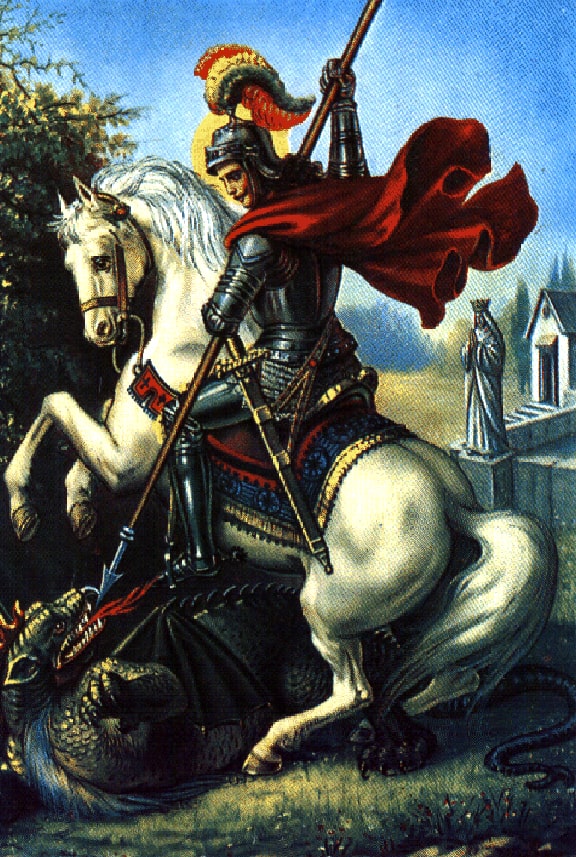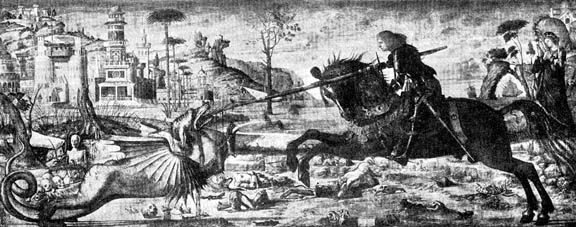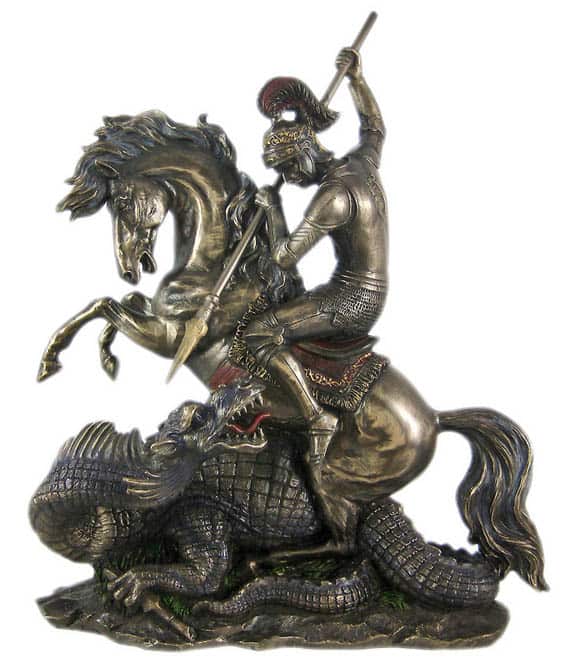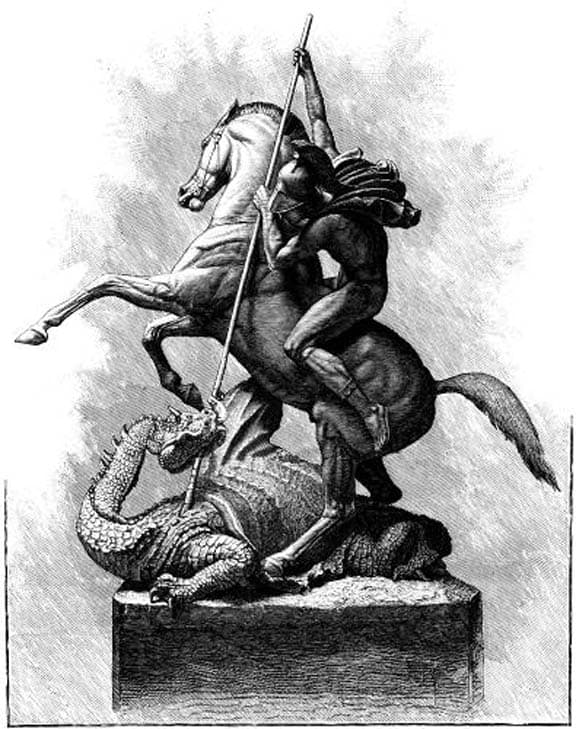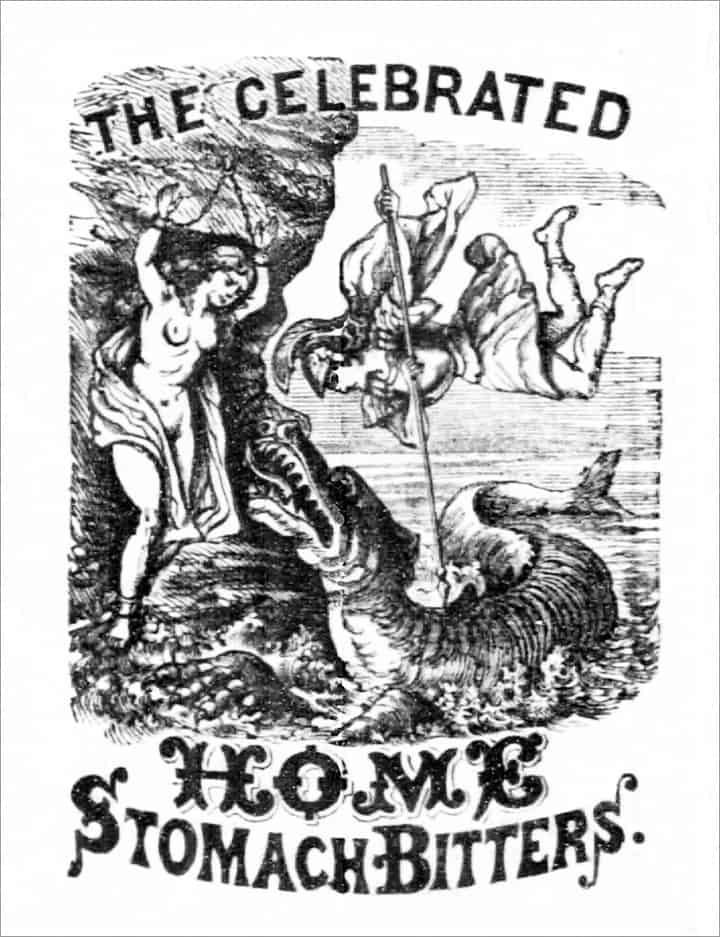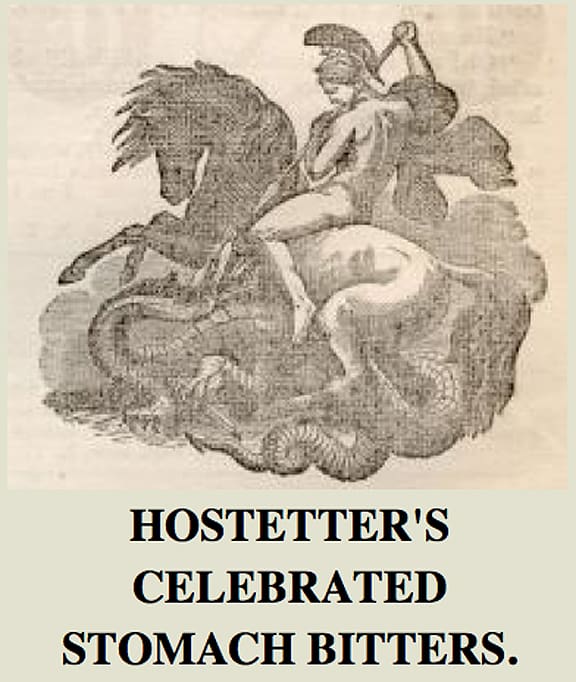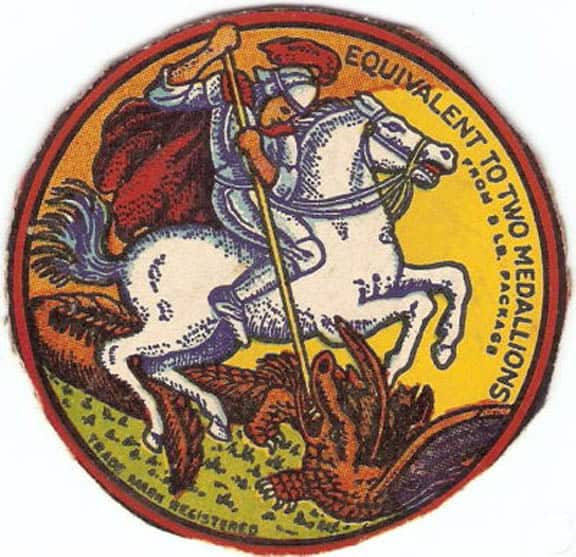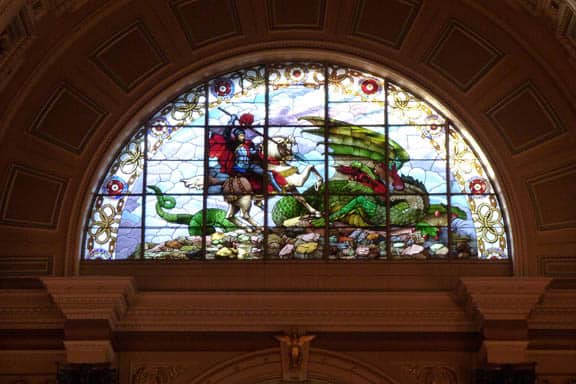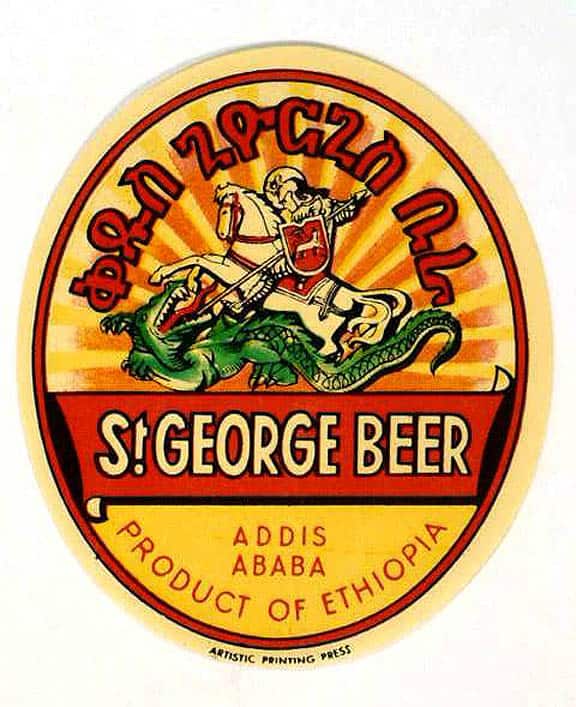Saint George the Dragon Slayer – Not only on Hostetter’s
25 October 2012 (R•051015)
![]() The recent post of a picture of a Hostetter’s Celebrated Stomach Bitters and a New Factory Smoking Tobacco can (see below) by Steve Ketcham has prompted some dialogue across the Internet that wanted to be corralled into a post. Specifically today, I wanted to look at Saint George the dragon slayer, the related iconography and where else the famous imagery occurs. We all know it did not start with Hostetter’s.
The recent post of a picture of a Hostetter’s Celebrated Stomach Bitters and a New Factory Smoking Tobacco can (see below) by Steve Ketcham has prompted some dialogue across the Internet that wanted to be corralled into a post. Specifically today, I wanted to look at Saint George the dragon slayer, the related iconography and where else the famous imagery occurs. We all know it did not start with Hostetter’s.

The Hostetter’s Bitters has been in our collection for years. We found this tobacco tin at Heckler’s this fall. Compare the Hostetter logo to the logo on the tobacco tin. The two are remarkably similar – Steve Ketcham
To do so, each day they offer the dragon at first a sheep, and if no sheep can be found, then a maiden must go instead of the sheep. The victim is chosen by drawing lots. One day, this happens to be the princess. The monarch begs for her life to be spared, but to no avail. She is offered to the dragon, but there appears Saint George on his travels. He faces the dragon, protects himself with the sign of the Cross, slays the dragon, and rescues the princess.
Saint George
Saint George (c. 275/281 – 23 April 303) was, according to tradition, a Roman soldier from Syria Palaestina and a soldier in the Guard of Diocletian, who is venerated as a Christian martyr. In hagiography Saint George is one of the most venerated saints in the Catholic (Western and Eastern Rites), Anglican, Eastern Orthodox, and the Oriental Orthodox churches. He is immortalized in the tale of Saint George and the Dragon and is one of the Fourteen Holy Helpers. His memorial is celebrated on 23 April, and he is regarded as one of the most prominent military saints.
Many Patronages of Saint George exist around the world, including: Georgia, England, Egypt, Bulgaria, Aragon, Catalonia, Romania, Ethiopia, Greece, India, Iraq, Lithuania, Palestine, Portugal, Serbia, Ukraine and Russia, as well as the cities of Genoa, Amersfoort, Beirut, Botoşani, Drobeta Turnu-Severin, Timişoara, Fakiha, Bteghrine, Cáceres, Ferrara, Freiburg, Kragujevac, Kumanovo, Ljubljana, Pérouges, Pomorie, Preston, Qormi, Rio de Janeiro, Lod, Lviv, Barcelona, Moscow and Victoria, as well as of the Scout Movement and a wide range of professions, organizations and disease sufferers.
Saint George and the Dragon
Eastern Orthodox depictions of Saint George slaying a dragon often include the image of the young maiden who looks on from a distance. The standard iconographic interpretation of the image icon is that the dragon represents both Satan (Rev. 12:3) and the Roman Empire. The young maiden is none other than the wife of Diocletian, Alexandra. Thus, the image as interpreted through the language of Byzantine Iconography, is an image of the martyrdom of the saint.
The episode of Saint George and the Dragon was a legend brought back with the Crusaders and retold with the courtly appurtenances belonging to the genre of Romance. The earliest known depiction of the legend is from early eleventh-century Cappadocia (in the iconography of the Eastern Orthodox Church, George had been depicted as a soldier since at least the seventh century); the earliest known surviving narrative text is an eleventh-century Georgian text.
In the fully developed Western version, which developed as part of the Golden Legend, a dragon or crocodile makes its nest at the spring that provides water for the city of “Silene” (perhaps modern Cyrene in Libya or the city of Lydda in the Holy Land, depending on the source). Consequently, the citizens have to dislodge the dragon from its nest for a time, to collect water. To do so, each day they offer the dragon at first a sheep, and if no sheep can be found, then a maiden must go instead of the sheep. The victim is chosen by drawing lots. One day, this happens to be the princess. The monarch begs for her life to be spared, but to no avail. She is offered to the dragon, but there appears Saint George on his travels. He faces the dragon, protects himself with the sign of the Cross, slays the dragon, and rescues the princess. The citizens abandon their ancestral paganism and convert to Christianity.
The dragon motif was first combined with the standardised Passio Georgii in Vincent of Beauvais’ encyclopaedic Speculum Historiale and then in Jacobus de Voragine’s “Golden Legend”, which guaranteed its popularity in the later Middle Ages as a literary and pictorial subject.
The parallels with Perseus and Andromeda are inescapable. In the allegorical reading, the dragon embodies a suppressed pagan cult. The story has other roots that predate Christianity. Examples such as Sabazios, the sky father, who was usually depicted riding on horseback, and Zeus’s defeat of Typhon the Titan in Greek mythology, along with examples from Germanic and Vedic traditions, have led a number of historians, such as Loomis, to suggest that George is a Christianized version of older deities in Indo-European culture.
In the medieval romances, the lance with which St George slew the dragon was called Ascalon, named after the city of Ashkelon in the Levant. [source Wikipedia]
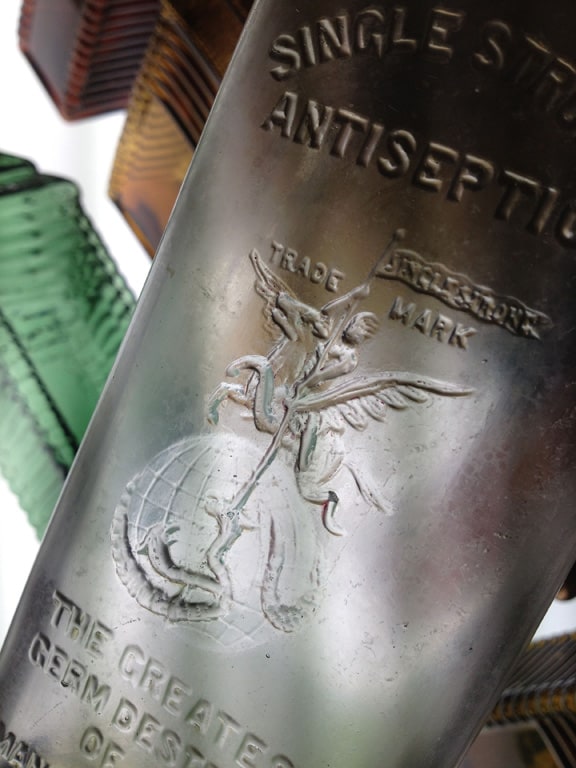
A great embossing of St. George slaying a dragon on a SINGLE STROKE ANTISEPTIC – Brad Seigler (at the 2012 Houston Bottle Show)

SINGLE STROKE ANTISEPTIC THE GREATEST GERM DESTROYER OF ALL MANUFACTURED BY THE WALKER CHEMICAL COMPANY DALLAS TEXAS. Both one of a kind. The company was only in business for one year. The bottles are from two different molds. The graphic is of the myth of St. George who cured a village of illness by slaying a dragon – Brad Seigler
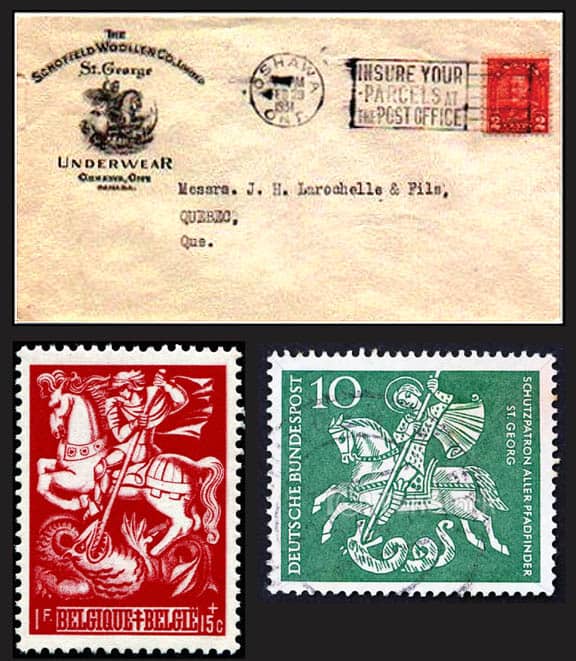
(top) Advertising cover for St. George Underwear, sent in 1931 by Schofield Woollen Co. at Oshawa, Canada.(bottom left) St. George slaying the Dragon, semi-postal stamp printed by photogravure, and issued by Belgium on June 25, 1944, (bottom right) Germany 1961 St. George Killing the Dragon
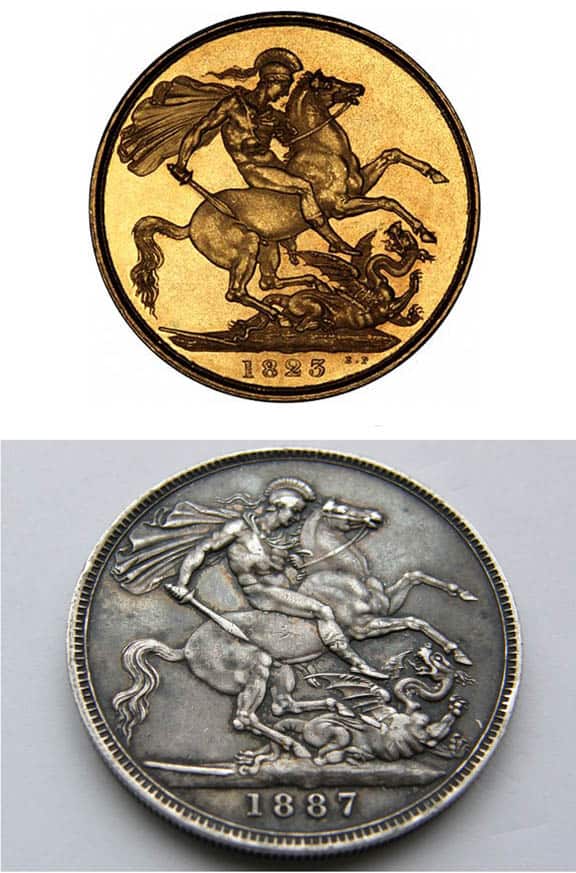
(top) St George & Dragon on Reverse on 1823 Gold Two Pound Coin (bottom) Queen Victoria Jubilee Crown. 1887 St George Slaying the Dragon.

1921 Ad – Hostetter Stomach Bitters – 60 Water Street Pittsburgh, PA – eBay

Two examples of Hostetter’s Celebrated Stomach Bitters bar signs. You can see St. George and the Dragon in both examples
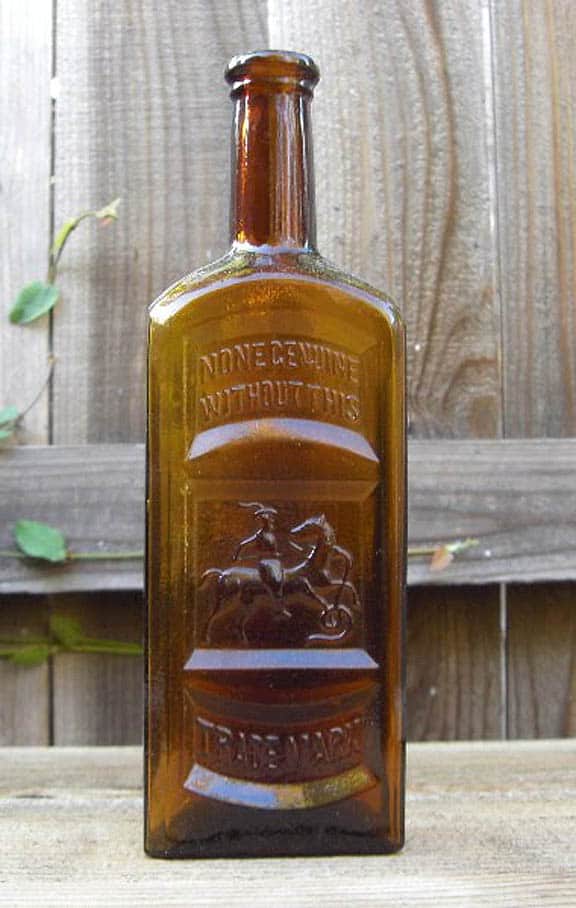
OK, it’s most likely NOT a Bitters, but does anyone have any information about what this bottle might have contained? The embossed scene on the bottle is reminiscent of the Hostetter’s label, showing St George slaying the dragon. In this case it appears to be a snake. It is trade marked, but not in the CA State Archives book of applications. To the best of my knowledge, they are only dug in the West. I have dug amber examples, here locally, and found a aqua specimen at a show. – Mike Dolcini (Western Bitters News)

